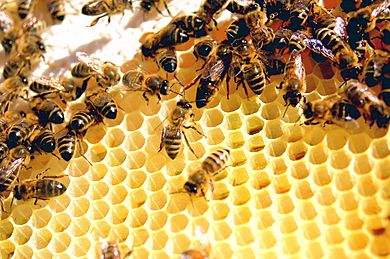Kin selection facts for kids

Kin selection is a cool idea in evolution that explains why animals sometimes help their relatives, even if it means a cost to themselves. Think about it like this: if you help your brother or sister, you're helping to pass on some of the same genes that you share. This can be a good strategy for genes to survive and spread over many generations.
Contents
What is Kin Selection?
Kin selection is an evolutionary strategy. It means that an organism's actions can favor the success of its relatives. This can happen even if it costs the organism's own survival or ability to have babies. It's all about shared genes.
Helping Your Relatives
Imagine an animal that gives an alarm call to warn its family about a predator. This might put the animal itself in danger. But, if it saves many of its close relatives, then the genes they share will survive. This is a type of helpful behavior called altruism. Kin selection helps us understand why animals might act in these selfless ways.
Charles Darwin's Early Thoughts
The famous scientist Charles Darwin first talked about this idea. He wrote about it in his 1859 book, On the Origin of Species. Darwin wondered why some insects, like worker bees, don't have their own babies. Instead, they spend their lives helping the queen bee raise her young. This seemed to go against his idea of natural selection, where individuals compete to survive and reproduce.
Darwin realized that selection could apply to a whole family, not just one individual. If helping relatives meant that more shared genes were passed on, then the behavior could still evolve.
How Animals Recognize Family
For kin selection to work, animals need to be able to tell who their relatives are. This is called kin recognition. Animals use different ways to do this:
- Smell: Many animals can recognize family members by their unique scent.
- Sounds: Some birds and mammals recognize their relatives by their calls or voices.
- Appearance: Sometimes, animals might recognize family by how they look.
- Where they grew up: Animals often treat others they grew up with as family, even if they aren't directly related.
Examples in the Animal Kingdom
Kin selection is seen in many different species:
- Social Insects: Ants, bees, and wasps are great examples. Worker ants and bees often don't reproduce. Instead, they help their queen raise her offspring. This is because they are very closely related to the queen and her young.
- Vervet monkeys: These monkeys show a behavior called allomothering. This is when females, like older sisters or grandmothers, help care for young monkeys. They are more likely to help if they are closely related to the baby.
- Plants: Even plants show signs of kin selection! Some plants, like morning glories, grow smaller roots when they are next to their relatives. This means they compete less for resources, helping their family members grow better.
Kin Selection and Genes
Kin selection explains how genes can become more common over generations. This happens because of helpful interactions between related individuals. If a gene causes an animal to help its relatives, and those relatives then survive and reproduce, the gene itself gets passed on more often. It's a powerful way that evolution shapes how animals behave, especially within families.
Images for kids
-
Charles Darwin wrote that selection could be applied to the family as well as to the individual.
-
The evolutionary biologist John Maynard Smith used the term "kin selection" in 1964.
-
Vervet monkeys behave in ways that imply kin selection.
-
Families are important in human behaviour, but kin selection may be based on closeness and other cues.
See also
 In Spanish: Selección de parentesco para niños
In Spanish: Selección de parentesco para niños








